You can listen to Hoosier History Live! live on the air each Saturday, or listen online at the WICR website during the broadcast on any computer with speakers, anywhere, or on a smartphone. We invite you to visit our website!
June 11 show
Brazilian immigration with artist Artur Silva
 According to folklore, the west-central Indiana town of Brazil derives its name only indirectly from the South American nation. The town took the name of a nearby farm called Brazil that, in turn, appropriated it merely because the country had been in the news frequently during the 1840s.
According to folklore, the west-central Indiana town of Brazil derives its name only indirectly from the South American nation. The town took the name of a nearby farm called Brazil that, in turn, appropriated it merely because the country had been in the news frequently during the 1840s.
More than 160 years later, though, Brazilian immigrants and visitors are creating a splash in many ways on Hoosier soil. Among the wave makers is acclaimed Indianapolis artist, clothing designer and cultural organizer Artur Silva, who will join Nelson in studio to share insights about immigration from his colorful homeland.
A recipient of the prestigious Efroymson Contemporary Arts Fellowship for 2010-11, Artur has been a co-organizer during recent pre-Lenten seasons of Indy Brazilian Carnaval, including a festive celebration last March that was the largest in the city's history, with about 600 attendees. The Indianapolis Star, in fact, dubbed it "the hottest party" of the Mardi Gras season in the metro area.
Artur, 35, is a native of Belo Horizonte City (translation: "beautiful horizon"), a city in southeastern Brazil that's surrounded by mountains. His artwork (Artur creates in several media, including painting, sculpture, digital media and photographic collages) has been seen by thousands of Hoosiers. It includes installations in White River State Park and, for about a year, the sparkling "MASS" letters that stood at the gateway to the Massachusetts Avenue arts district in Indy.
"My work focuses on the American experience," says Artur, who moved to Indy in 2001 after a few years in New York City. "Brazilians have come here in recent years for no one single reason, but to pursue all walks of life. I know Brazilians who work for Lilly and Rolls Royce, I know people who do cleaning work and babysitting, and I know artists and musicians."
 Artur's studio is at the Harrison Center for the Arts in the Old Northside neighborhood of Indy. Coincidentally, the Harrison Center, 1505 N. Delaware St., will be the setting Saturday for the Independent Music and Art Festival, beginning at noon, right when Hoosier History Live! with Artur signs off, and lasting until 8 p.m. For more info about the festival, visit harrisoncenter.org.
Artur's studio is at the Harrison Center for the Arts in the Old Northside neighborhood of Indy. Coincidentally, the Harrison Center, 1505 N. Delaware St., will be the setting Saturday for the Independent Music and Art Festival, beginning at noon, right when Hoosier History Live! with Artur signs off, and lasting until 8 p.m. For more info about the festival, visit harrisoncenter.org.
Artur's website is at www.artursilva.com. His artwork has been exhibited across the country and overseas - everywhere, in fact, from the Fort Wayne Museum of Art to galleries in Chicago, Los Angeles, the Netherlands and his native Brazil.
He tries to return once per year to his homeland and estimates about 1,000 people with Brazilian heritage now live in the Indy metro area. Obviously, then, scores of non-Brazilians attended the Indy Brazilian Carnaval that he organized with a business partner, Indianapolis radio disc jockey Kyle Long.
"The idea with Carnaval is for Brazilians to invite the rest of the world to share our culture and joy," Artur says of the festival, which featured samba music and dancing. "Carnaval was brought to Brazil in the 1600s by the Portuguese, but it really became popular when people from other cultures joined the celebration."
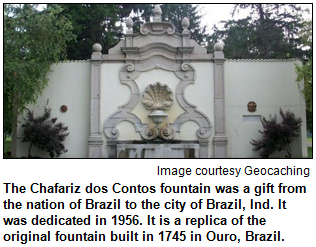 Also with Kyle Long, Artur has created Cultural Cannibals, a line of street wear and other apparel.
Also with Kyle Long, Artur has created Cultural Cannibals, a line of street wear and other apparel.
In addition to the Efroymson fellowship, Artur is a 2011 recipient of the Pollack-Krasner Foundation Grant. He plans to use some of the fellowship awards to study historic cemeteries - specifically, tombstones - as inspiration for his artwork.
Artur, who is in the process of becoming an American citizen, says "the buzz" is increasing in his homeland about the Indianapolis 500 because of the steady presence of Brazilian drivers in the race, including four of the 33 in the most recent field: Helio Castroneves, Tony Kanaan, Vitor Meira and Ana Beatriz. Race enthusiasts will recall there almost was a fifth. Bruno Junqueira - who, like Artur, is a native of Belo Horizonte - qualified among the 33 fastest drivers but was replaced days before the race in a controversial deal among car owners.
"It's taken awhile for (the Indy 500) to get a lot of attention in Brazil because the racing heritage was with Formula One," Artur says. "Now, though, there is much more buzz."
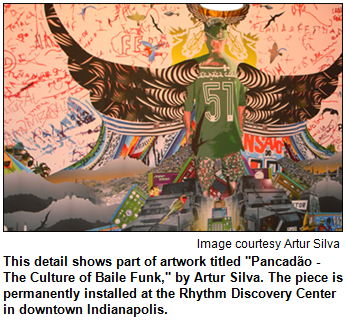 And, even though the Clay County city of Brazil derived its name indirectly from the country, the town for many decades has had a sister-city relationship with a city in southern Brazil. In fact, Forest Park in Brazil, Ind., features a large granite fountain that was a gift from the country. The fountain is a replica of Chafariz Dos Contos Fountain, a historic fountain in the South American nation.
And, even though the Clay County city of Brazil derived its name indirectly from the country, the town for many decades has had a sister-city relationship with a city in southern Brazil. In fact, Forest Park in Brazil, Ind., features a large granite fountain that was a gift from the country. The fountain is a replica of Chafariz Dos Contos Fountain, a historic fountain in the South American nation.
During our show, Artur will explain his reasons for immigrating to America, his initial reactions to Indianapolis and his observations about the capital city's art scene. He also will share the Brazilian perspective on terms such as "Hispanic" and "Latino."
During our recent show about populations shifts, Indiana University demographer Matt Kinghorn noted the state's Hispanic population grew 82 percent during the last decade. He also indicated the increase in Hoosier residents of Hispanic heritage accounted for 43 percent of the state's overall population growth.
History Mystery question
The History Mystery question is a carry-over from last week, when there wasn't a correct answer. The question concerns famous composer Hoagy Carmichael, who died in southern California in 1981. In accordance with his wishes, Hoagy is buried in Bloomington, Ind. 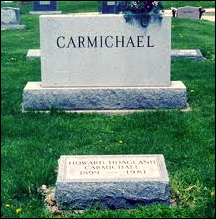 His grave is in a historic cemetery that also is the burial site of other notable Hoosiers. They include Ross Lockridge Jr., author of the classic novel "Raintree County," IU sex researcher Alfred Kinsey and Andrew Wylie, IU's first president.
His grave is in a historic cemetery that also is the burial site of other notable Hoosiers. They include Ross Lockridge Jr., author of the classic novel "Raintree County," IU sex researcher Alfred Kinsey and Andrew Wylie, IU's first president.
Question: Name the historic cemetery in Bloomington.
To win the prize, you must call in with the correct answer during the live show. The call-in number is (317) 788-3314, and please do not call until you hear Nelson pose the question on the air. Please do not call if you have won a prize from any WICR show during the last two months. The prize is a gift certificate to Tavern on South, next to Lucas Oil Stadium, courtesy of the Indianapolis Convention and Visitors Association, and a pair of tickets to Conner Prairie, courtesy of Conner Prairie.
Roadtrip: South Bend museums
Chris Gahl of the ICVA tells us to head up north to South Bend to see two incredible museums that are side by side. "Get all your history in one place," says Chris.
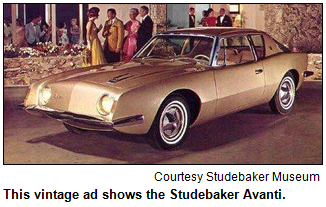 The Center for History in South Bend includes the Joseph D. Oliver mansion, known as Copshaholm, as well as the mansion's historic gardens, a worker's home reflecting a Polish immigrant family in the 1930s, and an exhibit called Women Who Played Hard Ball, The Real League of their Own.
The Center for History in South Bend includes the Joseph D. Oliver mansion, known as Copshaholm, as well as the mansion's historic gardens, a worker's home reflecting a Polish immigrant family in the 1930s, and an exhibit called Women Who Played Hard Ball, The Real League of their Own.
Right next door is the famed Studebaker Museum, with enough vintage cars to satisfy any automobile lover's appetite.
This Roadtrip was suggested by Joan Hostetler, originally of Kosciusko County, Indiana. She also recommends dining at the nearby Tippecanoe Place, which is in a mansion originally owned by the Studebaker family.
Your Hoosier History Live! team,
Nelson Price, host and creative director
Molly Head, producer, (317) 927-9101
Chris Gahl, Roadtripper
Richard Sullivan, webmaster and tech director
Pam Fraizer, graphic designer
Garry Chilluffo, creative consultant
Michele Goodrich, Jed Duvall, grant consultants
www.hoosierhistorylive.org
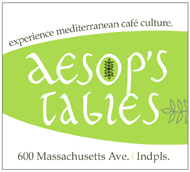






Please tell our sponsors that you appreciate their support: Aesop's Tables, Broad Ripple Brewpub, Heritage Photo and Research Services, Indiana Historical Society, Lucas Oil, Story Inn and The Society of Indiana Pioneers.
 Acknowledgments to Print Resources, Indianapolis Marion County Public Library, Monomedia, Indiana Humanities, Indianapolis Convention & Visitors Association, WICR-FM, Fraizer Designs, Chelsea Niccum and many other individuals and organizations. We are an independently produced program and are self-supporting through organizational sponsorships, grants and through individual tax-deductible contributions through the Indiana Humanities Council. Visit our website to learn how you can support us financially.
Acknowledgments to Print Resources, Indianapolis Marion County Public Library, Monomedia, Indiana Humanities, Indianapolis Convention & Visitors Association, WICR-FM, Fraizer Designs, Chelsea Niccum and many other individuals and organizations. We are an independently produced program and are self-supporting through organizational sponsorships, grants and through individual tax-deductible contributions through the Indiana Humanities Council. Visit our website to learn how you can support us financially.
June 18 show
Angelo Pizzo on 'Hoosiers,' 'Rudy' and a new movie
If you are the screenwriter of a film named "best sports movie of all time" by the likes of ESPN and USA Today, is it any wonder you would be named a Living Legend? Before Hoosiers (1986) filmmaker Angelo Pizzo of Bloomington receives that accolade from the Indiana Historical Society next month, he will join Nelson in studio.
The grandson of Sicilian immigrants, Angelo is renowned for his screenplays inspired by true Indiana sports stories.  In addition to Hoosiers, which was based on the 1954 upset victory of tiny Milan High School in the state basketball tournament, Angelo wrote the screenplay for Rudy (1993), which focused on a University of Notre Dame football story.
In addition to Hoosiers, which was based on the 1954 upset victory of tiny Milan High School in the state basketball tournament, Angelo wrote the screenplay for Rudy (1993), which focused on a University of Notre Dame football story.
For both of those movies, Angelo collaborated with his Indiana University fraternity brother, director David Anspaugh, who also will be named an Indiana Living Legend at the gala on July 29.
During our show, Angelo will share news and details about a current movie project that has come his way unexpectedly. It's a film based on a true episode in NASCAR history. Although that project doesn't have an Indiana setting, Angelo has been renowned for his allegiance to the Hoosier state both professionally and personally; after living in southern California for decades, he moved back to Bloomington because he wanted to raise his two young sons in his hometown.
Angelo, who also wrote the screenplay for The Game of Their Lives (2005), a movie about the triumph of an American soccer team, serves on the board of the Heartland Film Festival.
In addition to Angelo and David, Indianapolis Colts president Bill Polian and Joyce Sommers, the former president of the Indianapolis Arts Center, will be named Living Legends.
© 2011 Hoosier History Live! All rights reserved.